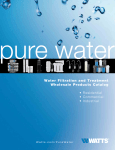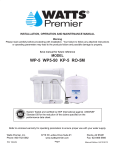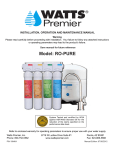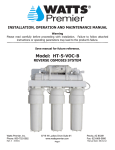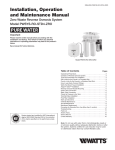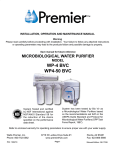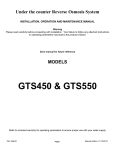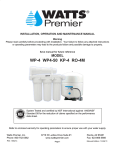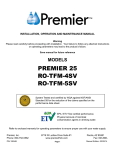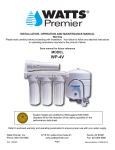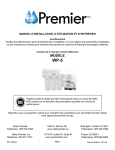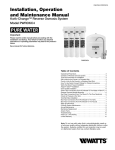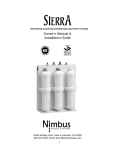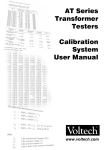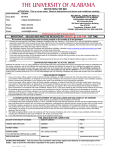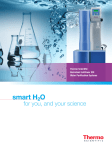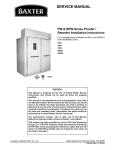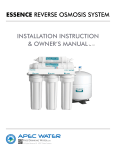Download PURE WATER - Watts Water Technologies
Transcript
IOM-WQ-PWRO4ZRO Installation, Operation and Maintenance Manual Zero Waste Reverse Osmosis System Model PWRO4ZRO PURE WATER ! WARNING Please read carefully before proceeding with installation. Your failure to follow any attached instructions or operating parameters may lead to the product’s failure. Keep this Manual for future reference. ! WARNING Do not use with water that is microbiologically unsafe or of unknown quality without adequate disinfection before or after the system. PWRO4ZRO IMPORTANT If you are unsure about installing your WATTS water filter, contact a WATTS representative or consult a professional plumber. ! CAUTION Test the water periodically to verify that the system is performing satisfactorily. Discard small parts remaining after the installation. NOTICE Failure to install the system correctly voids the warranty. Handle all components of the system with care. Do not drop, drag or turn components upside down. Be sure the floor under the water filter system is clean, level and strong enough to support the unit. System tested and certified by WQA against NSF/ ANSI Standard 58 for the reduction of the claims specified on the performance data sheet and NSF/ ANSI Standard 372 for lead free. Table of Contents Pages Operational Parameters . . . . . . . . . . . . . . . . . . . . . . . . . . . . . . . . . . . 3 Contents of Reverse Osmosis System . . . . . . . . . . . . . . . . . . . . . . . . 3 Tools Recommended For Installation . . . . . . . . . . . . . . . . . . . . . . . . . 3 Drill a Hole for the Faucet in a Porcelain Sink . . . . . . . . . . . . . . . . . . . 3 Punch a Hole for the Faucet in a Stainless Steel Sink . . . . . . . . . . . . . 3 How to use Quick-Connect Fittings . . . . . . . . . . . . . . . . . . . . . . . . . . 4 Watts Top Mount Faucet Installation . . . . . . . . . . . . . . . . . . . . . . . . . . 5 Adapt-A-Valve™ Installation . . . . . . . . . . . . . . . . . . . . . . . . . . . . . . . . 5 Reverse Osmosis Module Mounting . . . . . . . . . . . . . . . . . . . . . . . . . . 5 Green Tube Connection . . . . . . . . . . . . . . . . . . . . . . . . . . . . . . . . . . . 6 Black Tube Connection . . . . . . . . . . . . . . . . . . . . . . . . . . . . . . . . . . . . 6 Check Air Pressure in the Tank . . . . . . . . . . . . . . . . . . . . . . . . . . . . . . 6 Tank Ball Valve Installation . . . . . . . . . . . . . . . . . . . . . . . . . . . . . . . . . 6 Blue Tube Connection (to RO Tank) . . . . . . . . . . . . . . . . . . . . . . . . . . 6 Blue Tube Connection (from faucet) . . . . . . . . . . . . . . . . . . . . . . . . . . 6 Start Up Instructions . . . . . . . . . . . . . . . . . . . . . . . . . . . . . . . . . . . . . . 7 6-Month Maintenance . . . . . . . . . . . . . . . . . . . . . . . . . . . . . . . . . . . . 8 Annual Maintenance . . . . . . . . . . . . . . . . . . . . . . . . . . . . . . . . . . . . . . 8 Membrane Replacement . . . . . . . . . . . . . . . . . . . . . . . . . . . . . . . . . . 9 Procedure for Extended Non-Use (More than 2 months) . . . . . . . . . . . 9 Troubleshooting . . . . . . . . . . . . . . . . . . . . . . . . . . . . . . . . . . . . . . . . 10 Parts List . . . . . . . . . . . . . . . . . . . . . . . . . . . . . . . . . . . . . . . . . . . . . 11 Arsenic Facts . . . . . . . . . . . . . . . . . . . . . . . . . . . . . . . . . . . . . . . . . . 12 Performance Data Sheet . . . . . . . . . . . . . . . . . . . . . . . . . . . . . . . . . 13 Service Record . . . . . . . . . . . . . . . . . . . . . . . . . . . . . . . . . . . . . . . . . 14 Limited Warranty . . . . . . . . . . . . . . . . . . . . . . . . . . . . . . . . . . . . . . . 16 Introduction System Maintenance Just because you can not taste it, does not mean that it is not there. Contaminants such as lead, chromium and arsenic (to name a few) are undetectable to the taste. Additionally, over time if you do not replace the filter element, other bad tastes and odors will be apparent in your drinking water. Thank you for your purchase of a state of the art Watts Reverse Osmosis (RO) water treatment system. Water quality concerns are becoming more of a focus for the public. You may have heard about contaminants in the drinking water, such as Arsenic, Chromium, Cryptosporidium or Giardia. There may also be some local water issues such as high levels of Lead and Copper. This Watts water treatment system has been designed and tested to provide you with high quality drinking water for years to come. The following is a brief overview of the system. This is why it is important to change out your filter at the recommended intervals as indicated in this system manual. When replacing the filter elements, pay special attention to any cleaning instructions. Should you have any further questions please refer to our website at www.watts.com or call our customer service department at 1-800-244-1299. Your Reverse Osmosis System: Osmosis is the process of water passing through a semi-permeable membrane in order to balance the concentration of contaminants on each side of the membrane. A semi-permeable membrane is a barrier that will pass some particles like clean drinking water, but not other particles like arsenic and lead. With proper installation and maintenance, this system will provide you with high quality water for years to come. All of Watts water enhancement products are rigorously tested by independent laboratories for safety and reliability. If you have any questions or concerns, please contact our Customer Service department at 1-800-244-1299 or refer to our on-line troubleshooting at www.watts.com/purewater Reverse osmosis uses a semi-permeable membrane; however, by applying pressure across the membrane, it concentrates contaminants (like a strainer) on one side of the membrane, producing crystal clear water on the other. This is why RO systems produce both clean drinking water and waste water that is flushed from the system. This reverse osmosis system also utilizes carbon block filtration technology and can, therefore, provide a higher quality drinking water than carbon filtration systems alone. Your system is a 4-Stage RO which is based upon separate treatment segments within the one complete water filtration system. These stages are as follows: Stage 1 – Sediment filter, recommended change 6 months. The first stage of your RO system is a five-micron sediment filter that traps sediment and other particulate matter like dirt, silt and rust which affect the taste and appearance of your water. Stage 2 – Carbon filter, recommended change 6 months. The second stage contains a five-micron carbon block filter. This helps ensure that chlorine and other materials that cause bad taste and odor are greatly reduced. Stage 3 - Membrane, recommended change 2-5 years. Stage 3 is the heart of the reverse osmosis system, the RO membrane. This semi-permeable membrane will effectively take out TDS, Sodium and heavy metals such as arsenic, copper, and lead, as well as cysts, such as Giardia and cryptosporidium. Because the process of making this high quality drinking water takes time, your RO water treatment system is equipped with a storage tank. Stage 4 - Carbon in-line filter, recommend change 6 - 12 months. The final stage is an in-line granular activated carbon (GAC) filter. This filter is used after the water storage tank, and is used as a final polishing filter. Replacement Filter Packs Model PWFPKSEDCB PWFPK4RO4 PWMEM50 PWILGAC10 Frequency 6 Months Master Filter Kit 2 - 5 years Annual Description Includes sediment and carbon filter only Includes all filters and membrane 50 gpd membrane 10" final in-line filter NOTICE Water conditions may require more frequent cartridge replacement 2 STEP 1 Operational Parameters Drill a Hole for the Faucet in a Porcelain Sink Operating Temperatures Operating Pressure pH Parameters Iron TDS (Total Dissolved Solids) Turbidity Maximum 100°F (37.8°C) Maximum 85psi (6.0 kg/cm2) Maximum 11 Maximum 0.2 ppm < 1800 ppm < 5NTU Most sinks are predrilled with 1½" or 1¼" diameter hole that you can use for your RO faucet. (If you are already using it for a sprayer or soap dispenser, see Step 2). Minimum 40°F (4.4°C) Minimum 40psi (2.80 kg/cm2) Minimum 2 NOTICE Porcelain sinks are extremely hard and can crack or chip easily. Use extreme caution when drilling. Watts accepts no responsibility for damage resulting from the installation of faucet. Step A – Determine desired location for the RO faucet on your sink and place a piece of masking tape on over where the hole is to be drilled. Mark the center of the hole on the tape. Hardness: Recommended hardness not to exceed 10 grains per gallon, or 170ppm. System will operate with hardness over 10 grains but the membrane life may be shortened. Addition of a water softener may lengthen the membrane life. Water Pressure: The operating water pressure in your home should be tested over a 24 hour period to attain the maximum pressure. If the incoming water pressure is above 85psi a pressure regulator is recommended and if over 100psi then a pressure regulator is required. Step B – Using a variable speed drill set on the slowest speed, drill a 1⁄8" pilot hole through both porcelain and metal casing of sink at the marked center of the desired location. Use lubricating oil or liquid soap to keep the drill bit cool (If drill bit gets hot, it may cause the porcelain to crack or chip). Copper Tubing: Reverse Osmosis water should not be run through copper tubing as the purity of the water will leach copper causing an objectional taste in water and pin holes may form in the tubing. Watts supplies speciality filters that can be used if copper tubing follows the Reverse Osmosis unit. Be sure to follow any state or local regulations during installation. Note: RO unit must be installed a minimum of 25 Pipe feet from water heater. Step C – Using a 1¼" hole saw, proceed to drill the large hole. Keep drill speed on the slowest speed and use lubricating oil or liquid soap to keep the hole saw cool during cutting. NOTICE System was tested in a laboratory setting utilizing a hot water heater of 40 gallons set at 120°F. Performance may vary if your heater is smaller than 40 gallons or set above 120°F, contact the manufacturer for additional details. Step D – Make sure the surroundings of the sink are cooled before mounting the faucet to the sink after drilling and remove all sharp edges. System should not be used on homes equipped with a backflow prevention on the hot water heater. This device is 100% efficient, as no water is lost to drain in the production of the RO water. Contents of Reverse Osmosis (RO) System OR 1 Tank Punch a Hole for the Faucet in a Stainless Steel Sink 1 RO Module 1 Parts Bag – With a 10" Final Filter If mounting faucet to a Stainless Steel Sink, you will need a 1¼" Hole Punch. The faucet opening should be centered between the back splash and the edge of the sink, ideally on the same side as the vertical drain pipe. 1 Faucet Bag 1 Manual If any of the items are missing please contact prior to installing. Tools Recommended for Installation • 1¼" Hole Saw Bit for Faucet opening Step A – Drill a ¼" pilot hole. Use a 1⁄2" Hole Punch and an adjustable wrench to punch the hole in the sink. Change to the 1¼" Hole Punch to enlarge the hole • Round Knockout Punch for Stainless Sinks 1¼" • Adjustable Wrench • Sharp Knife • 1⁄2" & 5⁄8" Open End Wrenches The faucet can now be installed. • Phillips Screw Driver • Needle Nose Pliers – Adjustable Pliers • Electric Drill • 1⁄8" Drill Bit • 1⁄4" Drill Bit • 3⁄8" Drill Bit 3 How to use the Quick-Connect fittings on the RO Module To make a connection, the tube is simply pushed into the fitting. Place a piece of tape 1/2" from end of tube to indicate how far the tube should be inserted. The unique patented Quick-Connect locking system holds the tube firmly in place without deforming it or restricting flow. Cut the tube square. It is essential that the outside diameter be free of score marks and that burrs and sharp edges be removed before inserting into fitting. Fitting grips before it seals. Ensure tube is pushed into the tube stop. Push the tube into the fitting, to the tube stop. The collet (gripper) has stainless steel teeth which hold the tube firmly in position while the O-ring provides a permanent leak proof seal. Pull on the tube to check that it is secure. It is a good practice to test the system prior to leaving site and /or before use. To disconnect, ensure the system is depressurized before removing the tube. Push in collet squarely against face of fitting. With the collet held in this position, the tube can be removed. The fitting can then be reused. 4 STEP 2 STEP 3 Adapt-A-Valve™ Installation Verify contents prior to installation: Watts Chrome Top Mount Faucet Installation Minimum Mounting Hole Size Torque on Toggle Bolt ( 2 ) - Plastic Adapt-a-Valve™ & Black Collet ( 2 ) - Brass Adapter no washer ( 2 ) - Brass Adapter with black washer ( 2 ) - White rubber washer Maximum 1" 11⁄4" 5 lb.in. (max) NOTICE Gather and identify the faucet pieces. Water supply line to the system must be from the cold water supply line only. Hot water will severely damage your system. Step A - Remove faucet base, faucet spout and 3/8" tube from the parts bag. NOTICE Step B - Connect the 3/8” BLUE tube to the 3/8” BLUE Fitting on base of the faucet. Do not use Teflon tape with the Adapt-A-Valve™. Step C - From above the sink, feed the faucet tubing & toggle bolt down through the 1¼" mounting hole in the sink. Ensure that the soft rubber gasket has the protective white paper removed from both sides and is uniformly positioned in between the base of the faucet and the top of the sink. For 3⁄8" Configuration Step D - Align the faucet base so that the handle is on the right side and the base is sitting flush on the sink top. Using a phillips head screwdriver, turn the screw located down the hole where the spout will be installed, clockwise until the toggle bolt secures the faucet base snug onto the sink top. For 1⁄2" Configuration (With Brass Fittings) * Insert White Washer Step E - Once the faucet base is securely fastened to the sink top, insert the faucet spout into the faucet base until it is fully seated. Turn the handle up (away from you) to the “OFF” position. Hot Supply (Without Brass Fittings) 1⁄2" Configuration Cold Supply Step A - T urn off the cold and hot water supply to the faucet by turning the angle stop valve completely off. Step B - Open cold and hot water sink faucet to relieve pressure. Step C - Choosing the configuration that fits your plumbing, attach the Adapt-A-Valve™ as illustrated in the photos above. STEP 4 Reverse Osmosis Module Mounting Step A – Determine best location for the RO module to be mounted to allow for future system maintenance. The parts bag has 2 self-tapping screws. Using an electric drill with a Phillips bit, screw them into the cabinet wall 6" apart and 16" from the bottom of the cabinet. Do not cut any RO system tubes at this time 5 STEP 5 STEP 8 Green Tube Connection Tank Ball Valve Installation Step A – Locate green tube attached to the RO Module. Insert the open end of the green 1⁄4" tube into the open 1⁄4" quick-connect fitting on the AdaptA-Valve™ making sure the tube is pushed in all the way to the tube stop. Step A – Wrap (7 to 12 turns) of Teflon® tape clockwise around the male pipe threads (MPT) on the Stainless Steel fitting on top of the tank. Step B – C onnect the green tube from the RO module to the Adapt-A-Valve™ that is connected to the cold water angle stop valve. Leave enough tube so it is not kinked and cut the tube to the desired length. Do not let the tape cover the opening. Step B – Thread the plastic elbow ballvalve (supplied in the parts bag) onto the stainless steel connection on the top of tank. Tighten using an adjustable wrench. Do not over tighten as plastic could crack. STEP 6 Black Tube Connection Step A – Locate black tube attached to the RO Module. Insert the open end of the black 1⁄4" tube into the open 1⁄4" quick-connect fitting on the AdaptA-Valve™ making sure the tube is pushed in all the way to the tube stop. Teflon® is a registered trademark of E.I. Dupont de Nemours & Company. STEP 9 Blue Tube Connection (to RO tank) Step A– P osition the RO storage tank in a desired location. You may stand it upright or lay it on its side (using the black plastic stand included). Step B – Connect the black tube from the RO module to the Adapt-A-Valve™ that is connected to the hot water angle stop valve. Leave enough tube so it is not kinked and cut the tube to the desired length. Step B– L ocate the 1/4" blue tube in the parts bag. Connect one end of the tube to the tee fitting attached to the inline polishing filter, clipped on to the RO membrane housing. Insert the tube into the open tee fitting and use a 5⁄8" wrench to tighten the white plastic nut securely. STEP 7 Step C– M easure the tube from the inline polishing filter the tank and cut it to length leaving a straight, square edge. To connect the blue tube to the ball valve fitting, slip the blue tube through the white compression nut, hand tighten the white nut and add 1/4 turn with a 5/8" wrench. Check Air Pressure in the Tank Check air pressure when tank is empty of water! Check air pressure in the storage tank when you notice a decrease in available water from the RO system. Air can be added with a bicycle pump using the schrader valve that is located on the lower side of the tank behind the blue plastic cap. Set the blue ball valve knob in-line with the blue tube, this is the “open” position. A connection to a refrigerator / ice maker may be tee’d into this blue tube and should be spliced in between the final filter and the RO faucet. Step A – T urn off the incoming water supply to the RO by turning the knob on the Adapt-A-Valve™ clockwise until it stops. (Follow the green tube away from the RO system to find the Adapt-AValve™.) STEP 10 Blue Tube Connection (from faucet) Step A– L ocate the 3/8" blue tube attached to the RO faucet. Connect the open end of the tube to the straight fitting attached to the inline polishing filter clipped on to the RO membrane housing. Insert the tube into the open fitting and use a 5⁄8" wrench to tighten the white plastic nut securely. Step B – Open the RO Faucet and allow water to drain from the tank until it is completely empty. When water from the RO faucet slows to a trickle, with the faucet still in the open position, you may add air to the tank to purge any left over water. This will ensure that the tank is completely empty. Step C – O nce all water in the tank is purged, check air pressure using an air pressure gauge, it should read between 5 - 7psi. (Digital air pressure gauge is recommended) Step D – F ollow startup procedure on Page 7. 6 Start Up Instructions ! WARNING To prevent the possibility of electrical shock, clean up any water on cabinet floor and dry all water from outside of RO unit. Step A– T urn on the incoming cold and hot water at the angle stop valves by turning the knob on the Adapt-A-Valve™ counterclockwise. Check the system for leaks and tighten push to be further in any fittings as necessary. (Check frequently over the next 24 hours to ensure no leaks are present). If you have connected your RO system to a refrigerator / ice maker, make sure the ice maker is off (do not allow water to flow to the ice maker) until flushing is complete and the tank has been allowed to fill completely. Connection from the RO to the ice maker system should have an in-line valve installed before the ice maker so it can easily be closed to prevent water flowing to the ice maker during start up and periodic maintenance. Your RO tank must be allowed to fill up fully in order for the ice maker system to work properly. Step B – Plug the 24 volt transformer power cord connector into the RO wire harness connector (labeled Transformer). Step C – P lug the transformer into the electrical outlet under the sink. Step D – O pen the RO faucet and leave it open until water begins to trickle out (it will come out slowly). Step E – A fter water trickles out of the faucet, close the RO faucet allowing the storage tank to fill with water. It may take 4 to 6 hours to fill the tank completely depending on the production capability of the membrane, local water temperature and water pressure. Ensure Ball Valve on the RO storage tank is open. During the fill period, you may hear water trickling due to the Reverse Osmosis Process. Step F – After the Tank has filled, open the RO Faucet to flush the tank completely to remove carbon particles from final filter. You will know that the tank is empty when the flow rate from the RO faucet is down to a trickle. Repeat this step two more times. The fourth tank can be used for drinking. NOTICE Flushing of the tank 3 times is only necessary during the initial startup and after replacing the membrane. NOTICE Your reverse osmosis system contains replaceable treatment components that are critical for effective containment reduction. Periodic inspection and following proper system maintenance is critical for continued performance. 7 6-Month System Maintenance Step E – Clean the filter housings (bowls) with a mild soap solution and rinse with water. Check O-rings and lubricate with water soluble lubricant. KY Jelly®, canola oil or other water based lubricants may be used. Petroleum based lubricants (such as Vaseline®) must not be used. Order filter by calling Watts at 1-800-224-1299 Item Needed: EDP# 7100110 Includes: • (1) Sediment Filter • (1) Carbon Block Filter Step A – T urn off the incoming water supply to the RO by turning the knob on the Adapt-A-Valve™ clockwise until it stops. NOTICE Step B – Open the RO Faucet and allow water to drain from the tank until it is completely empty. Before re-installing the filter bowls back on to the system, check O-rings to make sure they are still in place. Water may be saved in a container for drinking or to rinse system parts. Step F – Insert a new sediment filter (cloth like appearance) into the 1st filter housing which is the one on the water inlet side (green tubing from the Adapt-A-Valve™) of the RO system and re-install housing. Step C – L et system sit for 10 to 15 minutes after the tank is empty to let the system depressurize before attempting to remove filter housings. Step G – Insert the new Carbon Block filter (White end caps & plastic netting) into the second and third filter bowls and re-install housings. Step D – F or more leverage you may leave the RO module attached to wall of cabinet. If you are unable to access the module while it is mounted, remove it prior to changing filters. Starting with the closest housing (Stage 1), remove it by turning it clockwise (left), empty water, then discard filter. Continue on to the 2nd housing (Stage 2) and 3rd housing (Stage 3). NOTICE Do not over-tighten filter housing, overtightening may damage O-ring(s), cause water leaks, or affect system performance. Step H – Turn water supply on to the unit by turning the knob on the Adapt-A-Valve™ counterclockwise. Step I – Open the RO faucet and leave it open until water begins to trickle out (it will come out slowly). Step J – Close the RO faucet allowing the storage tank to fill with water. It may take 4 to 6 hours to fill the tank completely depending on the production capability of the membrane, local water temperature and water pressure. If you own a 4-Stage system, it will not have the third stage. A 4-Stage system has two vertical housings instead of three. Step E – Turn off the incoming water supply to the system by turning the Adapt-A-Valve™ clockwise until it stops. Keep the RO faucet open until the storage tank is completely drained. Annual Maintenance Order filter by calling Watts at 1-800-224-1299 Item Needed: # 7100110, 7100454 1/2 cup of hydrogen peroxide or household bleach. Includes: • (1) Sediment Filter • (1) Carbon Block Filter Step F – Open the membrane housing and re-install the RO membrane while making sure not to kink the O-rings. (Refer to “Membrane Replacement” section on Page 9 for directions on installing the membrane). Tighten the cap back on the housing and reconnect green tubing. • (1) Final In-Line Filter Step G – Remove filter housings Stage 1 and 2 and empty of water. NOTICE Sanitizing of unit is recommended. Before re-installing the filter bowls back on to the system , check O-rings to make sure they are still in place and lubricate with water soluble lubricant. Step A – Perform steps A through E in the Six Month System Maintenance. Step H – Insert the new sediment filter (cloth like appearance) into the 1st filter housing which is the one on the water inlet side (green tubing from the Adapt-A-Valve™) of the RO system and re-install housing. If not sanitizing the system skip to step H. Step B – Remove the RO membrane from its housing and rest in a clean sanitary place. (Refer to “Membrane Replacement” section on Page 9 for directions on removing the membrane). Replace cap onto empty membrane housing and re-connect green tubing. Step I – Insert the new Carbon Block filter (White End Caps) into the 2nd housing and re-install housing. NOTICE Step C – L eaving the filters out, replace Stage 1 and 2 empty filter housings (hand tight) onto unit. Measure & pour either 1⁄2 cup of hydrogen peroxide or common household bleach into the 1st filter housing (Stage 1) and hand tighten onto unit. Do not over-tighten filter housing, overtightening may damage O-ring(s), cause water leaks, or affect system performance. Step J – The final in-line filter is located on the blue tube between the storage tank and the RO faucet. Remove it by loosening the compression fittings on both ends of the filter and replace with new filter. (Discard used final filter after sanitizing). NOTICE Overtightening components can damage the system causing water damage and/or system failure. Step D – With the RO faucet in the closed position turn on the incoming water supply to the system by turning the AdaptA-Valve™ counterclockwise. Wait 1 minute for the unit to pressurize. Turn on the RO faucet and let the water run for 30 seconds. Turn off the RO faucet and let the unit rest for 2 minutes. Finally, open the RO faucet and let the water run for 5 more minutes. The arrow on the final filter must be pointing towards the RO faucet / away from the RO storage tank. This is a good time to check the air pressure in your storage tank. For instructions please see Page 9. 8 Step K – Follow Steps H through J in the Six Month System Maintenance (Page 8) for startup directions. Membrane Replacement Removing the Membrane Order membrane by calling Watts at 1-800-224-1299 Item Needed: # 7100122, Includes: • (1) RO Membrane Step A – Use a 5⁄8" wrench to remove the Green Tube fitting on the left side of the horizontal membrane housing (end with one elbow). Step B – Remove the cap from the membrane housing by turning it counterclockwise to loosen. This reverse osmosis system contains a replaceable component (the RO membrane) which is critical to the efficiency of the system. A double sided wrench may be purchased from Watts to aid with loosening the cap / filter housings. Replacement of this reverse osmosis membrane should be with one of identical specifications as defined by Watts to assure the same efficiency and contaminant reduction performance. Step C – Remove membrane housing from the holding clips. Using a pair of pliers, grip the PVC tube of the RO membrane and pull firmly on the membrane to remove from the housing and discard. Membranes have a life expectancy between 2 and 5 years, depending on the incoming water conditions and the amount the RO system is used. This reverse osmosis membrane is critical for effective reduction of total dissolved solids (TDS). The product water should be tested periodically to verify that the system is performing satisfactorily. Normally, a membrane would be replaced during a semiannual or annual filter change. However, if at any time you notice a reduction in water production or an unpleasant taste in the reverse osmosis water, it could be time to replace the membrane. Watts recommends replacing the membrane when TDS reduction falls below 75%. Installing the Membrane Step A – Lubricate the O-rings on the new membrane with a water soluble lubricant such as KY Jelly ®. Insert the end with the two black O-rings first into the housing. A water sample may be sent to Watts for a free diagnosis of your membrane performance. To send a water sample, use two (2) clean containers and fill ½ cup of tap water in one container and ½ cup of reverse osmosis water in 2nd container. Clearly label each sample. Send the samples to the address listed on the cover of this manual attention “Water Samples”. Watts will test the water and mail or call you with the results. Step B – Once membrane has been inserted into the housing you must take your thumbs and give a firm push to properly seat the membrane. Replace membrane housing cap and tighten. Step C – After replacing membrane housing into clips, attach the green tube to the elbow on cap using 5⁄8" wrench. Step A – Turn off the incoming water supply to the RO by turning the knob on the Adapt-A-Valve™ clockwise until it stops. Step D – Follow the Start Up Instructions on Page 7. Step B – Open the RO Faucet and allow water to drain from the tank until it is completely empty. Procedure for Extended Non-Use (More than 2 months) Turn off the water supply by turning the knob on the Adapt-AValve™ clockwise until it stops and open the RO faucet to empty the storage tank (Save a few ounces of RO water). Once the storage tank is empty, remove the membrane and place it in a sealed plastic bag with the RO water saved earlier and store in your refrigerator. For restart, reinstall membrane (See Page 9 for membrane installation procedure) and follow startup procedure on Page 7. 9 Troubleshooting Problem 1. Low/slow production Cause Solution Excessive air pressure in tank R elieve pressure at schrader valve on tank (set to 7psi with the tank empty) Pump not operating iring connection broken (plug 110 AC wall, plug back in at W wall and/or reconnect the 24 VAC wire harness connectors) Replace pump if needed Fouled membrane Replace membrane Plugged pre-filters Replace filters Crimped tubing Check tubes to make sure they are not kinked Angle stop or water line valve not fully opened Ensure valves are opened by turning valve handle counterclockwise until it stops 2. Milky colored water Air in the system Air in the system is a normal occurrence with initial start up of the RO system. This milky look will disappear during normal use within 1-2 weeks. If condition reoccurs after filter changes, drain tank 1 to 2 times. 3. Faucet Dripping Needs adjustment see page 12 4. Pump short cycles Ball valve on tank closed Open the ball valve on the top of the tank Blue tube blocked between the tank and RO system Faulty pressure switch Remove kinked/damaged section and replace if necessary Call for technical support 5. Bowl leaks at the top after changing the filters Damaged/Dry O-ring Lubricate with water soluble lubricant or replace O-ring as necessary (Do not use Vaseline® or other petroleum based lubricants) 6. Pump constantly running Electrical fault Faucet left on Call for technical support. Close faucet and let tank fill for 2 to 3 hours. Plugged pre-filters Replace filters 10 Parts List 9 FAUCET 3/8” BLUE TUBE 11 15 CARBON POST-FILTER 21 TEE FITTING FLOW 1/4” BLUE TUBE 22 2 2 CHECK 4 VALVE 23 FLOW RESTRICTOR 1/4” BLACK TUBE - BRINE 5 PRESSURE SWITCH 18 18 12 PERMEATE 26 MEMBRANE HOUSING 18 28 STORAGE TANK 1/4” GREEN TUBE 3 3 17 7 TRANSFORMER 19 25 20 25 14 8 SELENOID 27 13 TO KITCHEN SINK TO KITCHEN SINK 24 27 19 10 24 16 16 1/4” GREEN TUBE FEED WATER 1 ADAPT-A-VALVE 1 ADAPT-A-VALVE 6 PUMP HOT-WATER SHUT-OFF VALVE COLD-WATER SHUT-OFF VALVE SEDIMENT PRE-FILTER Item EDP 1 7300068 2 7300077 3 4 5 6 7 8 9 10 11 12 13 7300049 7300075 7300015 7300001 7300000 7300076 7100203 7100446 7100454 710122 7100330 ADAPT-A-VALVE™ MOUNTING CLIP - DOUBLE - INLINE FILTER TO MEMBRANE HOUSING MOUNTING CLIP - MEMBRANE HOUSING DOUBLE CHECK VALVE PRESSURE SWITCH BOOSTER PUMP - 1/4" QC TRANSFORMER SELENOID VALVE TOP MOUNT FAUCET - CHROME CARBON BLOCK FILTER GAC POST-FILTER REVERSE OSMOSIS MEMBRANE SEDIMENT FILTER 14 7300039 CONNECTOR - 1/4" M X 1/4" QC 15 7300029 CONNECTOR - 3/8"C X 1/4" M CARBON PRE-FILTER Description 11 Item EDP 16 17 18 19 20 21 22 23 24 25 26 27 28 29 7300034 7300031 7300032 7300033 7300036 7300073 7300038 7300025 7300044 7300081 7300042 7300060 7100174 7300090 DESCRIPTION ELBOW - 1/4" QC X 1/4" STEM ELBOW - 1/4" C X 1/4" M ELBOW - 1/4" C X 1/8" M ELBOW - 1/4" QC X 1/8" M BRASS HEX NIPPLE-BRASS - 1/4"M TANK SHUT-OFF VALVE TEE - MALE RUN 1/4" T X 1/4" M FLOW RESTRICTOR (not shown) FILTER HOUSING - BOWL - 10" - WHITE FILTER HOUSING - LID - 1/4" PORTS MEMBRANE HOUSING O-RINGS FOR FILTER HOUSING STORAGE TANK - 3 GAL WHITE 1/4" x 1/4" UNION Arsenic Facts Arsenic (As) is a naturally occurring contaminant found in many ground waters. Arsenic in water has no color, taste or odor. It must be measured by an arsenic test kit or lab test. Public water utilities must have their water tested for arsenic. You can obtain the results from your water utility contained with in your consumer confidence report. If you have your own well, you will need to have the water evaluated. The local health department or the state environmental health agency can provide a list of test kits or certified labs. There are two forms of arsenic: pentavalent arsenic (also called As (V), As (+5)) and trivalent arsenic (also called As (III), As (+3)). In well water, arsenic may be pentavalent, trivalent, or a combination of both. Although both forms of arsenic are potentially hazardous to your health, trivalent arsenic is considered more harmful than pentavalent arsenic. RO systems are very effective at removing pentavalent arsenic. A free chlorine residual will rapidly convert trivalent arsenic to pentavalent arsenic. Other water treatment chemicals such as ozone and potassium permanganate will also change trivalent arsenic to pentavalent arsenic. A combined chlorine residual (also called chloramine) where it does convert trivalent arsenic to pentavalent arsenic, may not convert all the trivalent arsenic in to pentavalent arsenic. If you get your water from a public water utility, contact the utility to find out if free chlorine or combined chlorine is used in the water system. This Watts reverse osmosis system is designed to remove up to 98% of pentavalent arsenic. It will not convert trivalent arsenic to pentavalent arsenic. Under laboratory standard testing conditions, this system reduced 0.30 mg/L (ppm) pentavalent arsenic to under 0.010 mg/L (ppm) (the USEPA standard for drinking water). Actual performance of the system may vary depending on specific water quality conditions at the consumer’s installation. In addition to the independent laboratory standard testing conditions Watts has conducted additional field testing on our reverse osmosis units to determine trivalent arsenic reduction capabilities. Based upon Watts field testing, it has been determined that the RO units are capable of reducing up to 67% of trivalent arsenic from the drinking water. The RO membrane component of this Watts reverse osmosis system must be maintained according to its recommended maintenance cycle. Specific component identification and ordering information can be found in the installation/operation manual maintenance section, by phone at 1-800-224-1299 or online www.watts.com/purewater. 12 Performance Data Sheet PWRO4ZRO Zero Waste RO Watts Pure Water 8716 W Ludlow Drive Suite #1 Peoria, AZ 85381 1-(800)-224-1299 GENERAL USE CONDITIONS: 1. System to be used with municipal or well water sources treated and tested on regular basis to insure bacteriological safe quality. Do not use with water that is microbiologically unsafe or unknown quality without adequate disinfection before and after the system. Systems certified for cyst reduction may be used on disinfected water that may contain filterable cysts. 2. Operating Temperature: Maximum: 100°F (37.8°C) Minimum: 40° (4.4°) 3. Operating Water Pressure: Maximum: 100 psi (7.0kg/cm2) Minimum: 40 psi (2.8kg/cm2) 4. pH2 to 11 5. Hardness of more than 10 grains per gallon (170 ppm) may reduce TFM membrane life expectancy. 6. Recommend TDS (Total Dissolved Solids) not to exceed 1800 ppm. RECOMMENDED REPLACEMENT PARTS AND CHANGE INTERVALS: Depending on incoming feed water conditions replacement time frame may vary. DescriptionChange time Frame Sediment Pre-filter: #71003306 Months Carbon Pre-filter: #71004466 Months Final Carbon filter #7100454 12 Months R.O. Membrane: #7100122 2 to 5 years This system has been tested according to NSF/ANSI 58 for reduction of the substances listed below. The concentration of the indicated substances in water entering the system was reduced to a concentration less than or equal to the permissible limit for water leaving the system as specified in NSF/ANSI 58. This system has been tested for the treatment of water containing pentavalent arsenic (also known as As (V), As (+5), or arsenate) at concentrations of 0.30 mg/L or less. This system reduces pentavalent arsenic, but may not remove other forms of arsenic. This system is to be used on water supplies containing a detectable free chlorine residual at the system inlet or on water supplies that have been demonstrated to contain only pentavalent arsenic. Treatment with chloramine (combined chlorine) is not sufficient to ensure complete conversion of trivalent arsenic to pentavalent arsenic, Please see the Arsenic Facts section of the Performance Data Sheet for further information. Avg. In. Avg. Eff. % Reduction pH Pressure Max Eff. Inf. challenge Max Allowable (mg/L) (mg/L)mg/L concentration concentration mg/L mg/L Cysts 222,077#/ml 10 #/ml 99.99% 58 minimum 50,000/mL N/A Nitrate 26.0 mg/L 6.1 mg/L 76.5% 50 psi 10 mg/L 27±10% 10.0 Nitrite 2.8 mg/L 0.5 mg/L 82% 50 psi 0.77mg/L 3.0±10% 1.0 TDS 765 24 96.8% 7.84 750±40mg/L 187 Recovery - 18.0%Daily Production Rate - 11.0 GPD Efficiency - 10.4% Avg. In. Avg. Eff. % Reduction pH Pressure Max Eff. Inf. challenge Max Allowable (mg/L) (mg/L)mg/L concentration concentration mg/L mg/L Arsenic (Pentavalent) 334.62 ug/L 5.039 ug/L 98.4% 50psi 19 ug/L 0.30±10% 0.010 mg/L Barium Reduction 10.2 0.13 98.7% 7.24 50psi 0.27 10.0±10% 2.0 Cadmium Reduction 0.031 0.0001 99.7% 7.49 50psi 0.0009 0.03±10% 0005 Chromium (Hexavalent) 0.30 0.006 98.0% 7.24 50psi 0.013 0.03±10% 0.1 Chromium (Trivalent) 0.30 0.003 99.0% 7.24 50psi 0.008 0.03±10% 0.1 Copper Reduction 3.0 0.04 98.7% 7.64 50psi 0.06 3.0±10% 1.3 Fluoride Reduction 8.0 0.33 95.9% 7.49 50psi 0.47 8.0±10% 1.5 Lead Reduction 0.15 0.004 97.3% 7.49 50psi 0.008 0.15±10% 0.0107 Radium 226/228 25pCi/L 5pCi/L 80.0% 7.24 50psi 5pCi/L 25pCiL±10% 5pCiL Selenium 0.10 <0.001 99.0% 50psi <0.001 0.10±10% 0.05 Turbidity 81 NTU 0.15 NTU 99.8% 50psi 0.28 NTU 11±1 NTU 0.5 NTU Depending on water chemistry, water temperature, and water pressure, R.O. Systems production and performance will vary. Efficiency rating means the percentage of the influent water to the system that is available to the user as reverse osmosis treated water under operating conditions that approximate typical daily usage. Recovery rating means the percentage of the influent water to the membrane portion of the system that is available to the user as reverse osmosis treated water when the system is operated without a storage tank or when the storage tank is bypassed. There is an average of 4 gallons of reject water for every 1 gallon of product water produced. REFER TO OWNER’S INSTALLATION/SERVICE MANUAL FOR FURTHER MAINTENANCE REQUIREMENTS AND WARRANTY INFORMATION. 13 Service Record Date of Purchase Date 1st stage Sediment (6 months) Date of Install 2nd stage Carbon (6 months) 3rd stage Carbon (6 months) Notes: 14 Installed by Final Filter Carbon (1 year) TFM Membrane (2 – 5 years) 15 CALIFORNIA PROPOSITION 65 WARNING WARNING: This product contains chemicals known to the State of California to cause cancer and birth defects or other reproductive harm. For more information: Watts.com/prop65 LIMITED WARRANTY: Certain Watts Pure Water products come with a limited warranty from Watts Regulator Co. Other products may have no warranty or are covered by the original manufacturer’s warranty only. For specific product warranty information, please visit www.watts.com or the published literature that comes with your product. Any remedies stated in such warranties are exclusive and are the only remedies for breach of warranty. EXCEPT FOR THE APPLICABLE PRODUCT WARRANTY, IF ANY, WATTS MAKES NO OTHER WARRANTIES, EXPRESS OR IMPLIED. TO THE FULLEST EXTENT PERMITTED BY APPLICABLE LAW, WATTS HEREBY SPECIFICALLY DISCLAIMS ALL OTHER WARRANTIES, EXPRESS OR IMPLIED, INCLUDING BUT NOT LIMITED TO THE IMPLIED WARRANTIES OF MERCHANTABILITY AND FITNESS FOR A PARTICULAR PURPOSE, AND IN NO EVENT SHALL WATTS BE LIABLE, IN CONTRACT, TORT, STRICT LIABILITY OR UNDER ANY OTHER LEGAL THEORY, FOR INCIDENTAL, INDIRECT, SPECIAL OR CONSEQUENTIAL DAMAGES, INCLUDING, WITHOUT LIMITATION, LOST PROFITS OR PROPERTY DAMAGE, REGARDLESS OF WHETHER IT WAS INFORMED ABOUT THE POSSIBILITY OF SUCH DAMAGES. A Watts Water Technologies Company IOM-WQ-PWRO4ZRO 1505 USA: Tel: (800) 224-1299 • Fax: (978) 794-1848 • Watts.com/PureWater Canada: Tel: (905) 332-4090 • Fax: (905) 332-7068 • Watts.ca/PureWater Latin America: Tel: (52) 81-1001-8600 • Fax: (52) 81-8000-7091 • Watts.com/PureWater EDP# 2915899 © 2015 Watts
















